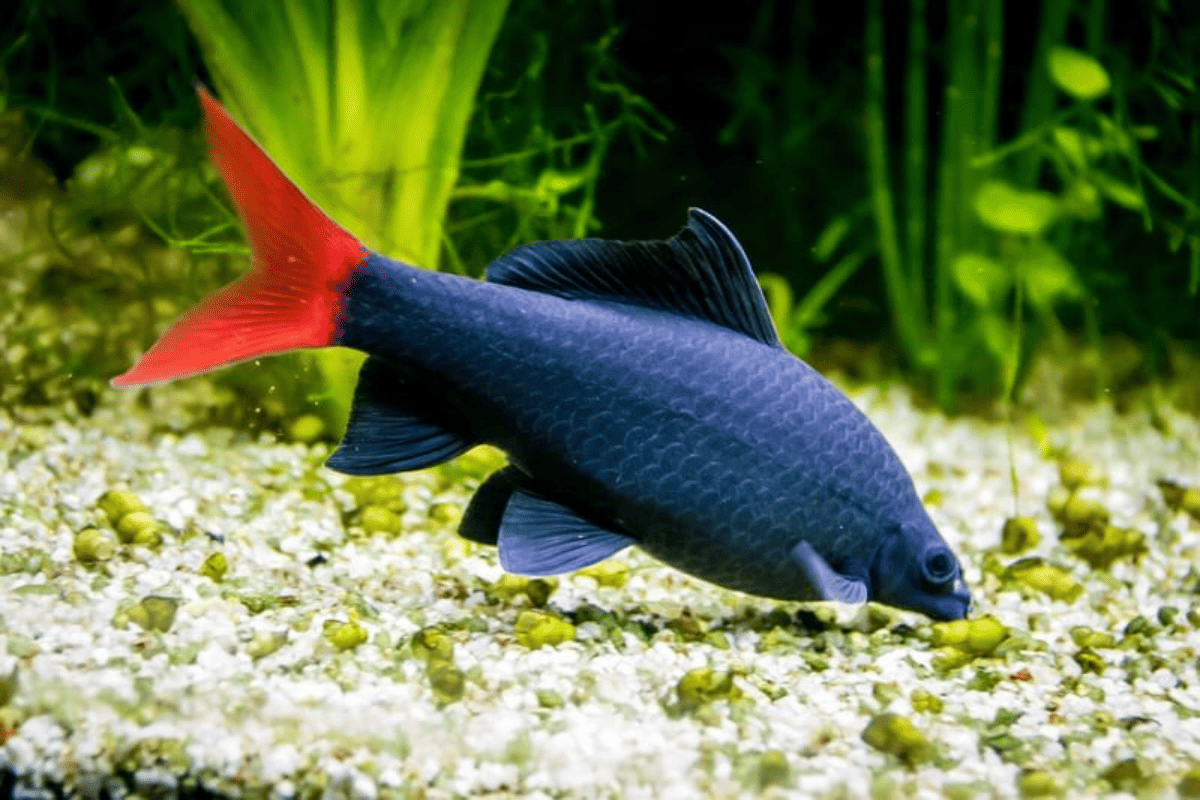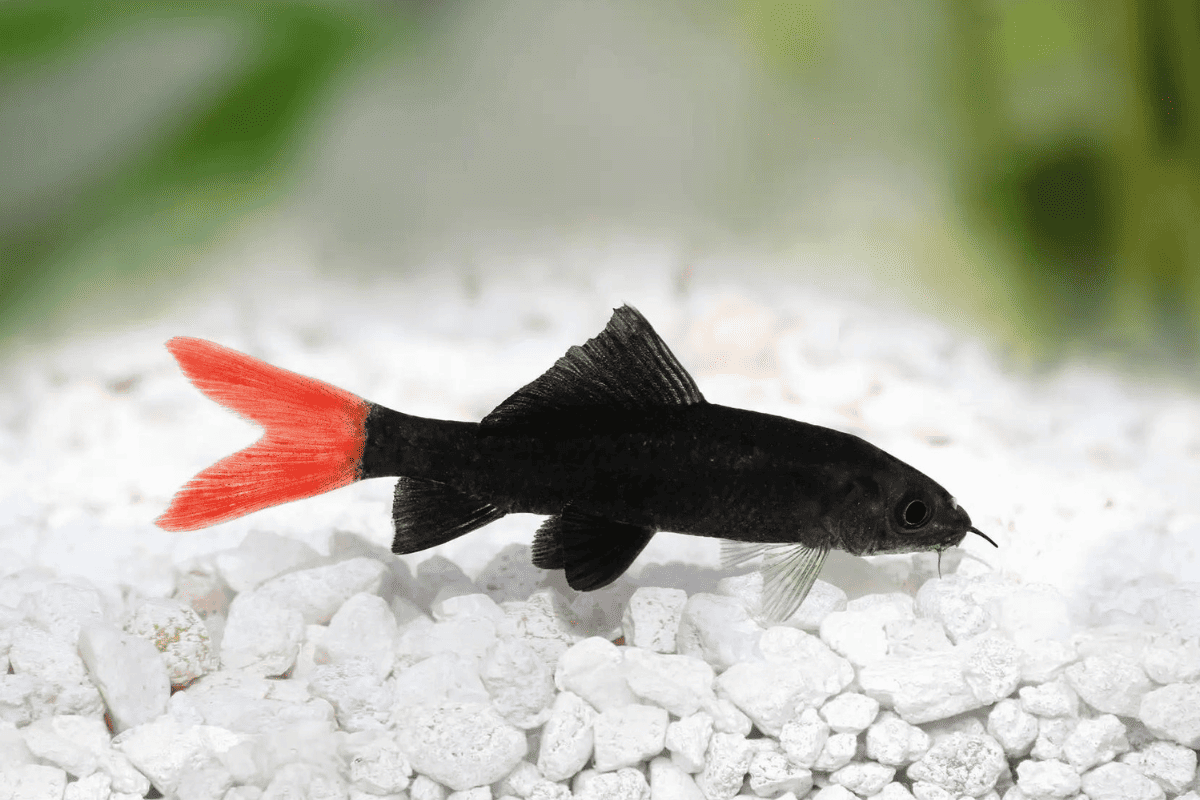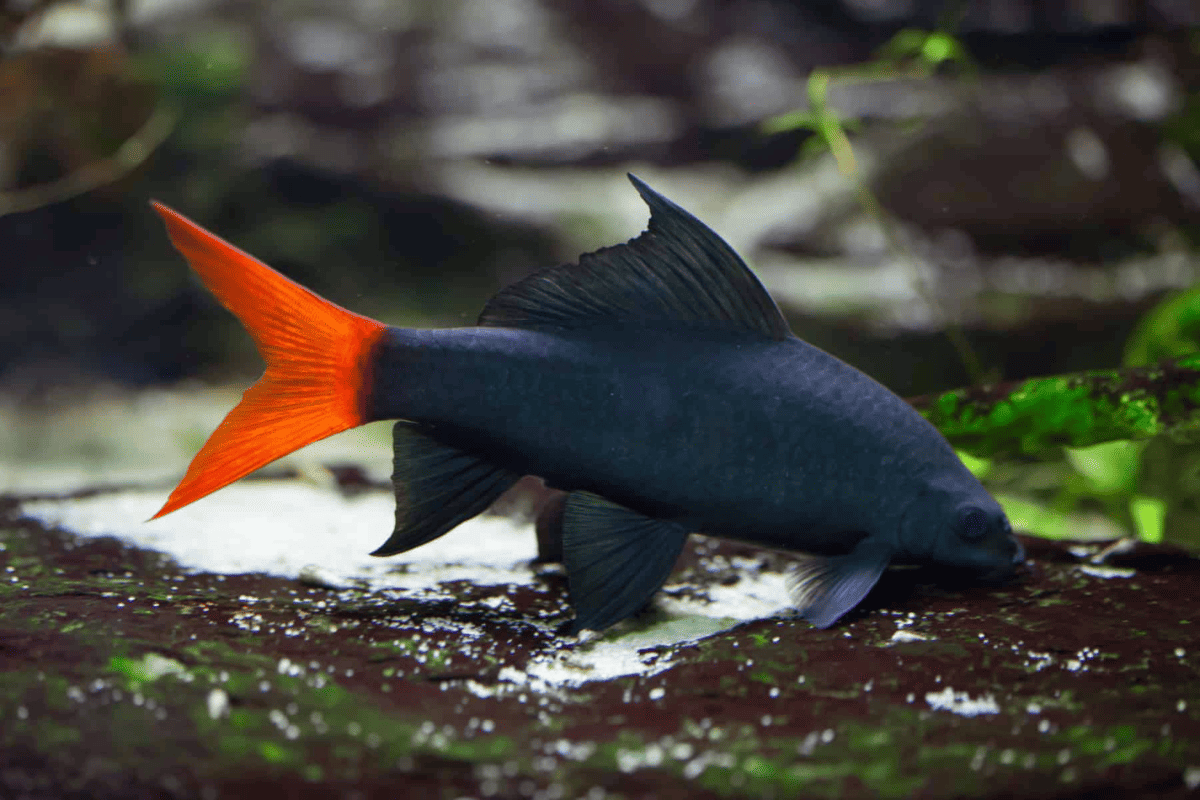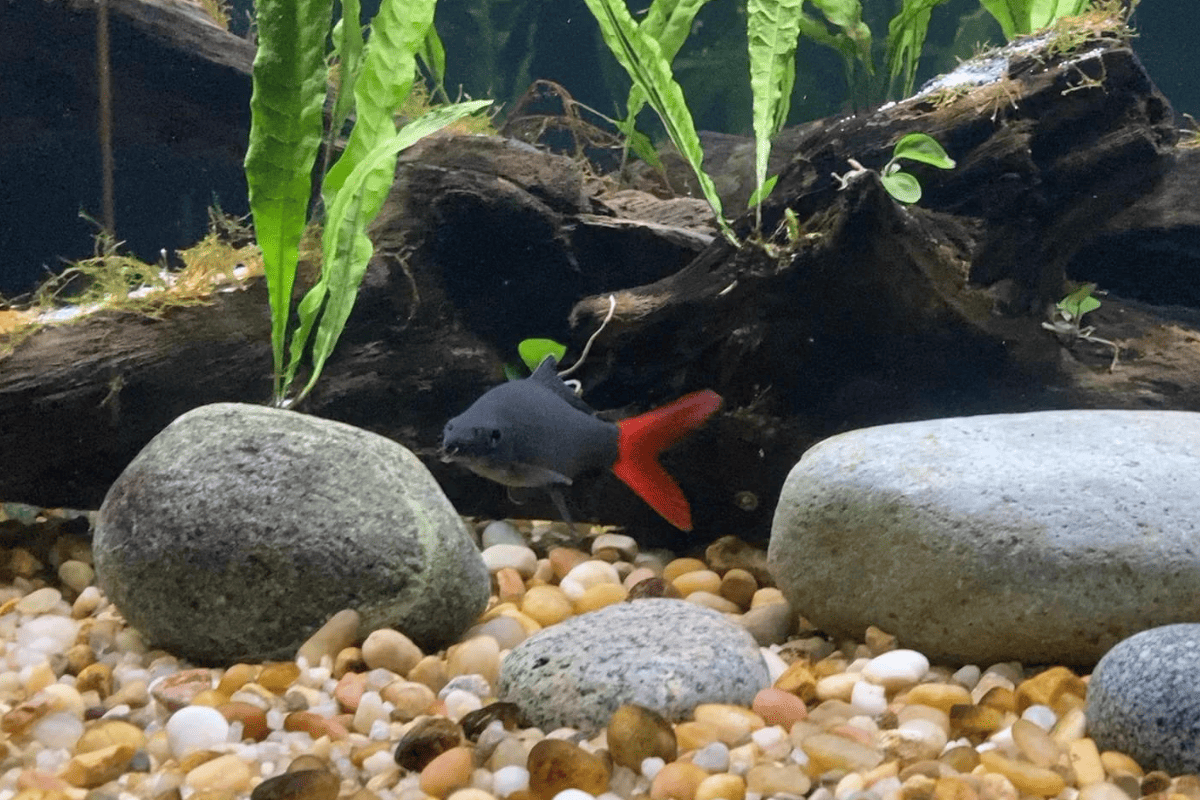Angelfish and Red Tail Sharks are popular choices for freshwater aquariums. However, is it possible for them to coexist peacefully?
Consider what is necessary to maintain them both. How does their need for space, water conditions, and diet matter?
When I first started with these fish, I was completely unaware of these details. That’s the reason I’m writing this article – to share what I’ve learned with you.
Let’s get started.

Can I Keep Angelfish and Red Tail Sharks Together in the Same Tank?
No, it is not advisable to keep Angelfish and Red Tail Sharks together in the same tank.
Angelfish require a peaceful environment, which the more aggressive Red Tail Sharks can disrupt.
- Behavioral Mismatch: Angelfish, with their tranquil demeanor, can become targets for the Red Tail Shark’s territorial aggression, leading to constant stress or injury.
- Environmental Needs: While Angelfish prefer planted areas to hide and lay eggs, Red Tail Sharks need ample open swimming space, leading to habitat competition.
- Stress Factors: The Red Tail Shark’s boisterous activity could prevent Angelfish from accessing food, resulting in nutritional deficiencies and weakened immune systems.
- Aggression Control: As Red Tail Sharks mature, their aggression intensifies, posing a severe risk to the slower-moving, more delicate Angelfish.
Also Read: Angelfish Tank Mates
Angelfish vs. Red Tail Sharks: Behavior
The first factor worth considering is the Angelfish’s and Red Tail Sharks’ natural behavior. Here is what you should know:
Angelfish: Natural Behavior
Angelfish are known for their grace and serenity in the aquatic environment. They exhibit a calm and somewhat territorial behavior, especially during breeding.
- Social Hierarchy: Angelfish establish a pecking order within their group; the dominant pair can become aggressive during spawning.
- Territorial During Breeding: Angelfish become highly protective of their area when laying eggs, often on flat vertical surfaces like leaves or tank glass.
- Peaceful Coexistence: Generally, Angelfish can coexist with similar-sized non-aggressive fish, preferring to swim and explore the mid-levels of the aquarium.

Red Tail Sharks: Natural Behavior
Red Tail Sharks are active and robust in nature, displaying a marked territorial instinct. They are more aggressive, especially towards their own kind or similarly shaped and colored fish.
- Lone Swimmers: Red Tail Sharks are often solitary and may claim a large territory, which they patrol and defend vigorously against intruders.
- Aggression Towards Similar Species: A Red Tail Shark can show significant aggression towards fish with similar body shapes and colors, which could include Angelfish.
- Active Foragers: These sharks are constantly on the move, searching the substrate for food, which can disturb more delicate species like Angelfish who prefer a tranquil setting.

Ideal Parameters for Angelfish and Red Tail Sharks
Ideal water parameters are crucial for the well-being of aquarium inhabitants. These parameters ensure Angelfish and Red Tail Sharks live in conditions suitable for their health.
| Parameter | Angelfish | Red Tail Sharks | Both Types |
| Temperature | 76°F to 82°F | 72°F to 79°F | 76°F to 79°F |
| pH Level | 6.5 to 7.0 | 6.5 to 7.5 | 6.5 to 7.0 |
| Water Hardness | 3 to 8 dGH | 5 to 15 dGH | 5 to 8 dGH |
Angelfish: Ideal Parameters
Angelfish thrive in a stable, tropical freshwater environment that closely mimics their Amazonian habitat.
Precise water conditions are key to maintaining their health and vibrant colors.
- Temperature Range: Angelfish prefer warmer waters, with an ideal temperature range between 76°F to 82°F (24°C to 28°C).
- pH Level: The optimal pH level for Angelfish lies slightly on the acidic side, around 6.5 to 7.0, which is reflective of their natural riverine conditions.
- Water Hardness: Angelfish do best in softer water, with general hardness between 3 to 8 dGH, ensuring their delicate fins remain healthy.

Red Tail Sharks: Ideal Parameters
Red Tail Sharks require stable water conditions that do not fluctuate widely to remain vibrant and active. They are more adaptable than Angelfish but still require specific parameters.
- Temperature Range: These sharks are comfortable in a temperature range similar to Angelfish, from 72°F to 79°F (22°C to 26°C), allowing for some overlap.
- pH Level: Red Tail Sharks can tolerate a broader pH range; their ideal conditions are from 6.5 to 7.5, accommodating slightly more neutral water.
- Water Hardness: They are quite adaptable to varying levels of water hardness, thriving in ranges from 5 to 15 dGH, which gives a little more flexibility compared to Angelfish.

Angelfish vs. Red Tail Sharks: Tank Setup
The tank setup is essential for providing a stress-free environment for Angelfish and Red Tail Sharks.
When housing both, the setup must meet the needs of each species without compromising the other’s habitat.
| Setup Aspect | Angelfish | Red Tail Sharks | Both Types |
| Tank Size | ≥ 55 gallons | ≥ 55 gallons | ≥ 75 gallons |
| Foliage | Dense | Moderate | Dense to Moderate |
| Decorations | Smooth rocks, driftwood | Rocks, caves | Combination of both |
| Filter | Gentle flow | Strong filtration | Strong with gentle areas |
| Heater | Yes | Yes | Yes |
| Substrate | Fine, soft | Medium gravel | Fine to medium |
| Pump | Moderate circulation | Moderate to strong | Moderate circulation |
| Lighting | Moderate | Bright | Moderate to Bright |
| Water Change Frequency | Weekly | Weekly | Bi-weekly (Depending on load) |
Angelfish: Tank Setup
Angelfish require a thoughtfully arranged tank to mimic their natural habitat, promoting health and reducing stress.
Stability in water quality and ample space for swimming and breeding are paramount for these graceful fish.
- Ammonia/Nitrite/Nitrate: Angelfish need pristine water conditions, with ammonia and nitrite at 0 ppm and nitrate below 20 ppm to avoid stress and illness.
- Tank Size: A group of Angelfish should be housed in at least a 55-gallon tank to provide enough space for their territorial behavior and tall body shape.
- Foliage: Live plants are essential, such as Amazon swords or Java ferns, offering hiding spots and replicating their native Amazonian environment.
- Decorations: Smooth-edged rocks and driftwood can be added, ensuring no sharp edges that Angelfish’s long fins could snag on.
- Filter: A high-quality filter that offers gentle water flow is ideal, as Angelfish do not appreciate strong currents that can stress them.
- Heater: A reliable heater is necessary to maintain the 76°F to 82°F temperature range Angelfish require.
- Substrate: A fine substrate, like sand or small rounded gravel, is preferred, mimicking the riverbeds of the Amazon and aiding in plant growth.
- Pump: An air pump providing moderate water circulation helps keep the water oxygenated without creating excessive turbulence.
- Lighting: Moderate lighting is sufficient for Angelfish, supporting plant life without causing undue stress or encouraging excessive algae growth.

Red Tail Sharks: Tank Setup
Red Tail Sharks are active swimmers and demand a spacious and well-structured environment for exploration and territorial behavior.
They are less demanding regarding vegetation but need sufficient room to establish a territory.
- Ammonia/Nitrite/Nitrate: Like Angelfish, Red Tail Sharks require 0 ppm for ammonia and nitrite, but they can tolerate slightly higher nitrate levels, up to 40 ppm.
- Tank Size: A minimum of 55 gallons is necessary for a single Red Tail Shark, with more space needed if housing multiple specimens to prevent aggression.
- Foliage: They are less dependent on plants but benefit from some cover like Java fern or Anubias for shelter and to break lines of sight.
- Decorations: Caves and larger rocks work well for Red Tail Sharks, providing hiding places and helping to delineate territories.
- Filter: A robust filtration system is critical to handle the waste produced by these active fish and to maintain clean water conditions.
- Heater: Consistent water temperature is crucial, so a heater that keeps the tank between 72°F to 79°F is ideal for Red Tail Sharks.
- Substrate: A darker substrate is often recommended to bring out the Red Tail Shark’s coloration, with a preference for medium-sized gravel.
- Pump: An efficient water pump that creates a moderate current will satisfy Red Tail Sharks’ need for water movement.
- Lighting: Brighter lighting is acceptable for Red Tail Sharks, as it does not affect them as much and can enhance their striking color contrast.

The Dietary Requirements of Angelfish and Red Tail Sharks
Dietary requirements for Angelfish and Red Tail Sharks reflect their omnivorous nature but differ in the specifics.
A tank with both fish types would need to cater to these specific dietary needs.
| Dietary Aspect | Angelfish | Red Tail Sharks | Both Types |
| Food Types | Flake, pellets, live/frozen | Algae-based flakes, vegetable pellets, live/frozen | Variety of both types |
| Quantity | As much as they can eat in 30 seconds | As much as they can eat in 1 minute | Moderate amounts for both |
| Feeding Schedule | 2-3 times/day | Once daily | 2 times/day |
Angelfish: Ideal Dietary Requirements
Angelfish are omnivorous and their diet in the wild consists of a mixture of both plant and animal matter.
In the aquarium setting, it’s important to replicate this varied diet to ensure good health and vibrant colors.
- Food Types: Angelfish diet should include high-quality flakes or pellets designed for them, supplemented with live or frozen foods like bloodworms and brine shrimp.
- Quantity: Feeding should be in moderation, offering only as much food as Angelfish can consume in about 30 seconds to avoid overfeeding and tank pollution.
- Feeding Schedule: Angelfish benefit from being fed small amounts two to three times a day, ensuring they receive constant nutrition without compromising water quality.

Red Tail Sharks: Ideal Dietary Requirements
Red Tail Sharks are primarily omnivores with a strong preference for plant-based foods, but they also need protein in their diet.
They are less likely to graze throughout the day compared to Angelfish, thus a structured feeding routine is crucial.
- Food Types: Their diet should be varied, consisting of algae-based flake foods, vegetable pellets, and occasional live or frozen protein like daphnia or bloodworms.
- Quantity: Red Tail Sharks should be fed a quantity they can finish in about a minute once a day, which helps prevent overeating and excess waste.
- Feeding Schedule: A consistent once-daily feeding schedule is sufficient for Red Tail Sharks, reducing the risk of overfeeding and maintaining water quality.

How to Introduce Your Angelfish to a Tank with Red Tail Sharks
Introducing Angelfish to a tank with Red Tail Sharks is risky due to potential aggression, but if you decide to proceed, careful planning and monitoring are crucial.
Ensure both species have plenty of space and hiding spots to retreat to if stressed.
- Tank Size Assessment: Verify the tank is spacious enough, ideally over 55 gallons, to give Angelfish and Red Tail Sharks enough room to establish territories.
- Multiple Hiding Places: Create numerous hiding spots with plants, rocks, or decorations to prevent the Red Tail Sharks from cornering the Angelfish.
- Monitor Aggression: Carefully observe the Red Tail Shark’s behavior towards the new Angelfish, ready to separate them at any sign of persistent aggression.
- Gradual Introduction: Use a tank divider or introduce the Angelfish in a breeding box to allow the Red Tail Sharks to get accustomed to their presence without direct contact.
- Feeding Strategy: Feed the Red Tail Sharks prior to the introduction to lessen their aggression, ensuring the Angelfish can explore their new environment with reduced risk.

Tips for Keeping Angelfish with Red Tail Sharks
Co-habitating Angelfish with Red Tail Sharks can be challenging due to their differing needs and temperaments, but with vigilant management, it’s not impossible.
Careful observation and a well-structured environment are key to maintaining harmony in the tank.
- Sizable Tank: Start with a large tank, at least 75 gallons, to provide ample space for both Angelfish and Red Tail Sharks to coexist.
- Defined Territories: Use tank dividers or decorations to create clear territories, especially for the Red Tail Sharks, to reduce territorial aggression.
- Plentiful Hiding Spots: Ensure there are numerous hiding spots for the Angelfish, as they will need places to retreat if chased by the Red Tail Sharks.
- Visual Barriers: Arrange plants and decorations to break the line of sight and prevent the Red Tail Sharks from seeing the Angelfish constantly.
- Careful Introduction: Introduce Angelfish to the tank first, allowing them to establish territory before adding the Red Tail Sharks to reduce potential conflict.
- Feeding Zones: Establish separate feeding areas to prevent competition for food, which can be a significant source of stress and conflict.
- Ongoing Monitoring: Continuously monitor fish interactions, being prepared to rearrange the tank or remove one species if aggressive behaviors persist.
Also Read: Can Angelfish And Rainbow Sharks Live Together?

Best Tank Mates for Angelfish and Red Tail Sharks
When selecting tank mates for Angelfish and Red Tail Sharks, choose species that can coexist with the temperament and environmental needs of both.
Peaceful, robust fish that occupy different areas of the tank make the best companions.
- Corydoras Catfish: These peaceful bottom dwellers are excellent tank mates for Angelfish and avoid the mid-water territories that Red Tail Sharks may patrol.
- Dwarf Gourami: Their calm nature and preference for the top and middle areas of the tank make them compatible with Angelfish, without encroaching on Red Tail Shark’s space.
- Zebra Danios: Fast swimmers and top dwellers, they are generally too quick for Angelfish and Red Tail Sharks to bother, making them suitable companions.
- Bristlenose Plecos: They stick to the tank bottom and algae cleaning, hence not competing with Angelfish for food or territory and are generally ignored by Red Tail Sharks.
- Boesemani Rainbow Fish: Their active swimming at the tank’s mid-level keeps them out of the Red Tail Shark’s bottom territory, and they are peaceful with Angelfish.
- Cherry Barbs: Being small and non-aggressive, they tend not to trigger territorial behavior in Red Tail Sharks and coexist peacefully with Angelfish.
Also Read: Can Angelfish And Barbs Live Together?

Conclusions
For quick readers, here’s a short summary:
- Keeping Angelfish and Red Tail Sharks together is not recommended due to behavioral incompatibilities and potential for aggression.
- While Angelfish prefer a peaceful, planted environment, Red Tail Sharks are active and require ample open swimming space, leading to habitat conflict.
- Angelfish and Red Tail Sharks have overlapping but distinct water parameter requirements, which can complicate tank management.
- The dietary needs of Angelfish and Red Tail Sharks are varied; both are omnivorous, but Angelfish need frequent, small feedings, while Red Tail Sharks do well with once-daily feedings.
- Introducing Angelfish to a tank with Red Tail Sharks requires careful planning and monitoring to mitigate stress and aggression.
